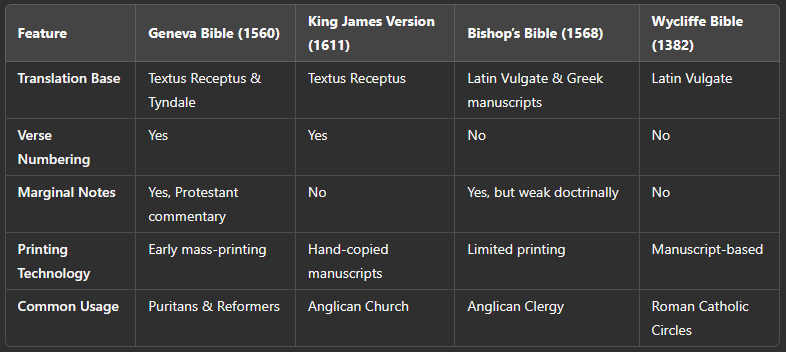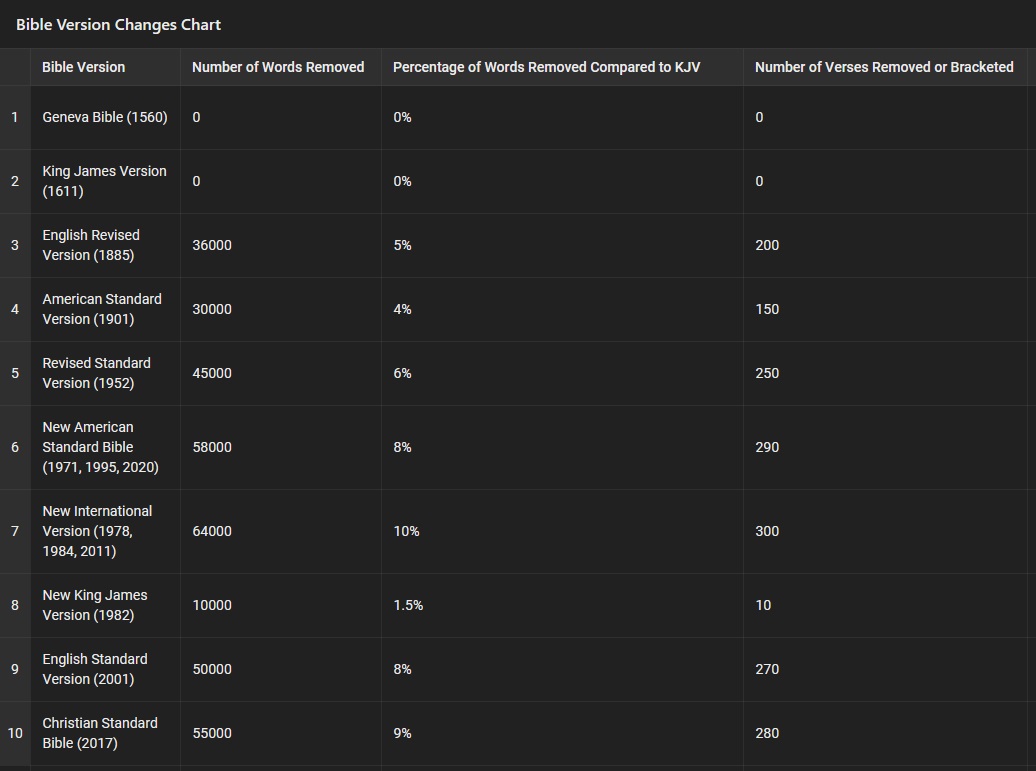Comparing English Bible Versions – Truth, Accuracy, and Doctrinal Integrity
The English Bible has undergone numerous revisions and translations since the Geneva Bible (1560) and the King James Bible (1611). While some updates were made for readability, many modern versions introduce doctrinal shifts, omit key verses, and alter the meaning of Scripture. Understanding these differences is crucial for believers seeking the most accurate, God-honoring translation.

🔥 The Bible – A Foundation Under Attack
The Bible is the inspired Word of God, given to humanity as a guide to salvation, truth, and righteousness. However, throughout history, the integrity of God’s Word has been challenged, altered, and in some cases, corrupted. While many assume that all modern Bible translations carry the same message, the reality is that significant changes have taken place—many of which distort key doctrines, remove critical teachings, and introduce subtle yet dangerous deceptions.
The question must be asked: Does every Bible version truly represent the Word of God, or have modern translations been deliberately altered to fit an agenda?
The Battle Over God’s Word
From the Garden of Eden to today, Satan’s primary strategy has been to twist and manipulate God’s words. His first recorded act of deception was altering God’s command in Genesis 3:1—“Yea, hath God said…?”—planting doubt in Eve’s mind. This same tactic continues today through subtle changes in Scripture that impact doctrine, prophecy, and even the deity of Christ.
Understanding the history and corruption of Bible versions is crucial for believers who desire to stand on the pure, unaltered Word of God. Many modern versions are based on manuscripts that differ significantly from the preserved text used by the early church and faithful translators throughout history.
The Two Competing Streams of Manuscripts
All English Bible translations are based on one of two major manuscript families:
1️⃣ The Majority Text / Textus Receptus (Received Text)
🔹 Used by faithful believers throughout church history.
🔹 Preserved by God’s providence and used for translations like the King James Version (KJV).
🔹 Aligns with the manuscripts used by the early church.
🔹 Maintains doctrinal purity, with no key omissions or alterations.
2️⃣ The Alexandrian Text (Critical Text / Westcott & Hort Text)
🔹 Derived from a minority of manuscripts (Vaticanus & Sinaiticus).
🔹 Formed the basis for most modern versions (NIV, ESV, NASB, etc.).
🔹 Contains thousands of deletions, doctrinal changes, and textual omissions.
🔹 Produced by men who held unorthodox beliefs about Christ and Scripture.
By comparing these two manuscript streams, it becomes clear that many modern translations systematically remove references to Jesus’ deity, diminish His atonement, and introduce confusion about core doctrines. The question then arises: Why would translators remove or change God’s Word unless there was an agenda behind it?
What Has Been Corrupted?
While some argue that modern translations simply make the Bible “easier to understand,” the deeper issue is that they change the actual meaning of Scripture. Many verses have been removed, altered, or paraphrased in a way that weakens biblical truth.
Some of the most concerning changes include:
🔹 The removal of entire verses (e.g., Matthew 17:21, Acts 8:37, 1 John 5:7).
🔹 The omission of Jesus’ name in key passages (e.g., Colossians 1:14).
🔹 The weakening of Christ’s divinity (e.g., 1 Timothy 3:16).
🔹 The removal of words tied to spiritual warfare (e.g., “Lucifer” in Isaiah 14:12 replaced with “morning star,” confusing Jesus with Satan).
🔹 Doctrinal shifts that downplay the blood of Christ, fasting, and repentance.
Each change, whether minor or major, influences how Scripture is interpreted and understood. When enough of these alterations accumulate, they create a different gospel—one that subtly undermines biblical truth.
How This Affects Prophecy & End-Time Deception
One of the most alarming aspects of Bible corruption is its effect on prophecy. Many modern versions weaken or obscure key prophetic passages related to the Antichrist, the Great Tribulation, and the return of Christ. By altering these passages, Satan seeks to confuse believers about end-time events, making them vulnerable to deception.
For example:
🔹 Revelation 13:18 (the verse about the mark of the beast) is phrased differently in some versions, creating confusion about its meaning.
🔹 2 Thessalonians 2:3 (which speaks of a falling away before the Antichrist is revealed) is changed in some versions to mean “the rapture,” altering the prophetic timeline.
🔹 Daniel 3:25 removes the phrase “the Son of God,” replacing it with “a son of the gods,” weakening the prophetic connection to Christ.
Satan knows that if he can corrupt the Bible, he can confuse the church and prepare the world for deception. This is why understanding the corruption of modern Bible versions is not a secondary issue—it is a matter of spiritual life and death.
Conclusion – Why This Study Matters
As believers, we are called to stand on the pure, unaltered Word of God. Jesus said, 📖 “Heaven and earth shall pass away, but my words shall not pass away” (Matthew 24:35). If we truly believe this, we must ask ourselves: Where is His Word preserved? Has God allowed His Word to be lost, or has He preserved it through faithful manuscripts and translations?
This study will expose the differences between Bible versions, analyze key changes, and equip readers with the knowledge to discern which Bible carries the true, uncorrupted Word of God.
Next, we will begin breaking down each English Bible version, examining what changed, who was behind it, and how it affects doctrine.
✅ The Geneva Bible (1560) – A Deep Discovery
The Geneva Bible (1560) was one of the most significant English translations of Scripture before the King James Version (1611). Born out of the Protestant Reformation, it was translated by English exiles in Geneva, Switzerland, many of whom fled the Marian Persecutions under Queen Mary I (“Bloody Mary”). Led by reformers such as William Whittingham, Myles Coverdale, and John Knox, the Geneva Bible became the first English translation to be fully accessible to the common people.
✨ Key Historical Facts:
First mass-printed English Bible, making Scripture widely available.
The first English Bible with numbered verses, setting a precedent for future translations.
Included extensive marginal notes, which interpreted Scripture from a Protestant perspective.
Based primarily on the Textus Receptus and influenced by Tyndale’s New Testament.
The Geneva Bible became the standard among Puritans and Pilgrims, even being carried on the Mayflower to America. It was favored for its accessibility and anti-monarchical notes, which challenged the divine right of kings.
Unlike the King James Version, which later sought to unify religious factions under one official translation, the Geneva Bible remained a tool of Protestant reformers who opposed the centralized power of the English monarchy and the Catholic Church.
Doctrinal Integrity & Translation Accuracy
Faithfulness to the Original Text
The Geneva Bible is built upon Tyndale’s earlier work, following the Textus Receptus, which aligns with the majority of Greek manuscripts. Unlike later translations influenced by Westcott & Hort’s Critical Text (late 19th century), the Geneva Bible holds doctrinal purity, preserving verses omitted in many modern versions.
Theological Emphasis
The Geneva Bible is staunchly Protestant, emphasizing salvation by faith alone, predestination, and individual study of Scripture. The marginal notes interpret the text in a way that:
Criticized the Catholic Church for adding traditions not found in Scripture.
Rejected the divine right of kings, which later led to its banning in England.
Encouraged private Bible study, which challenged the authority of state-controlled religion.
Persecution & Controversy
The Geneva Bible was beloved by Reformers but despised by royalty and high church authorities. The Church of England and King James I opposed its anti-authoritarian notes, leading to its suppression.
Why Was the Geneva Bible Banned?
Undermined the monarchy: Marginal notes in places like Exodus 1:19 suggested that civil disobedience was justifiable against tyrannical rulers.
Anti-Catholic commentary: It harshly criticized doctrines such as purgatory, indulgences, and the papacy.
Encouraged self-interpretation: By placing Scripture in the hands of the people, it threatened ecclesiastical control over doctrine.
Despite attempts to suppress it, the Geneva Bible continued to flourish underground and was carried by Pilgrims to America as the preferred translation of early Protestant settlers.
Notable Features & Innovations
1. Verse Numbering System
For the first time, readers could easily reference specific passages, an innovation later adopted by the King James Bible and modern translations.
2. Marginal Notes & Commentary
The Geneva Bible’s notes were essentially a Reformation-era study Bible, interpreting Scripture through the lens of:
Salvation by grace alone (Ephesians 2:8-9).
Rejection of papal authority (Matthew 16:18).
Prophetic interpretations regarding Antichrist and Babylon.
3. Portable & Affordable
Unlike massive pulpit Bibles, the Geneva Bible was designed for personal reading and study.
Used smaller Roman font instead of Gothic script, making it easier to read.
Examples of Verses Affected
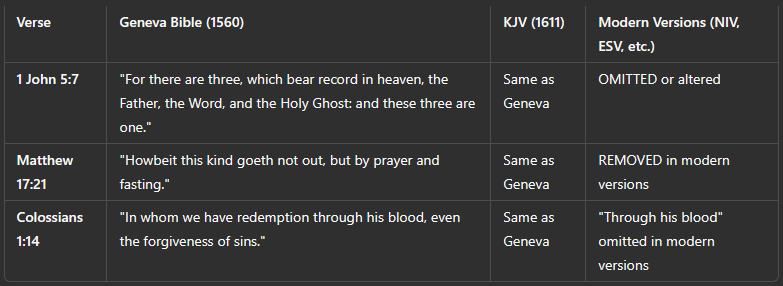
The Geneva Bible maintains doctrinal accuracy, aligning with the Received Text, whereas later versions omit critical phrases tied to Christ’s divinity, the blood of Jesus, and spiritual warfare.
Legacy & Modern Usage
Why the Geneva Bible Still Matters
Despite being overshadowed by the King James Bible, the Geneva Bible remains significant because:
It was the Bible of the Reformation.
It influenced early American Christianity (used by Pilgrims and Puritans).
It preserved important doctrinal truths that later translations altered or removed.
It laid the foundation for verse numbering and study notes, common in modern Bibles today.
Modern Reprints & Accessibility
Today, the Geneva Bible has been reprinted for historical and study purposes, though it remains less common than the KJV. Some scholars and believers still study it for its theological depth, Reformation influence, and textual reliability.
Conclusion: A Cornerstone of Reformation Truth
The Geneva Bible (1560) stands as one of the most influential English Bibles in history. It was a translation by the people, for the people, equipping believers with doctrinal clarity and historical insight. While later versions, such as the KJV, built upon its foundation, the Geneva Bible remains a vital witness to biblical preservation and the battle for doctrinal truth.
🔮 Next, we will analyze the Bishop’s Bible (1568) and its place in the history of English translations.
The Bishop’s Bible (1568) – A Deep Discovery
The Bishop’s Bible (1568) was commissioned as an official English translation by the Church of England under the reign of Queen Elizabeth I. It was intended to replace the Geneva Bible (1560), which had gained immense popularity among Protestants but was viewed as too radical due to its anti-monarchical notes. The Bishop’s Bible was primarily a revision of the Great Bible (1539), with influence from the Geneva Bible, yet it lacked the same level of scholarship and readability.
📜 Key Historical Facts:
Commissioned by Archbishop Matthew Parker and translated by bishops of the Church of England.
Designed to be the official church Bible, read in Anglican churches.
Revised from the Great Bible (1539) but heavily influenced by the Geneva Bible.
Rejected by Puritans who still preferred the Geneva Bible’s commentary.
Served as the direct predecessor to the King James Bible (1611).
The Bishop’s Bible was never widely accepted by the public and struggled to gain traction outside of official church use. It remained in liturgical settings but was eventually displaced by the King James Version (1611), which combined the best elements of earlier English translations.
Comparison to Other Bibles
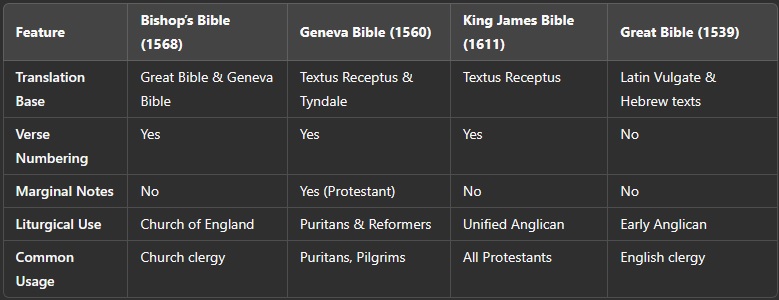
Unlike the Geneva Bible, which contained extensive Protestant commentary, the Bishop’s Bible omitted marginal notes to avoid political and doctrinal controversy. However, it was still influenced by Protestant theology, reflecting the shift away from Catholic traditions.
Doctrinal Integrity & Translation Accuracy
Faithfulness to the Original Text
While the Bishop’s Bible was based on earlier English translations, it was a weaker textual revision compared to the Geneva Bible. It relied heavily on the Great Bible (1539), which itself was a revision of Tyndale’s and Coverdale’s work. However, it lacked the scholarly precision of the Geneva Bible and contained many translation inconsistencies.
Theological Emphasis
The Bishop’s Bible was designed to align with Anglican theology, avoiding controversial interpretations. However, it retained Protestant themes, such as:
Justification by faith (Romans 3:28).
Authority of Scripture over tradition (2 Timothy 3:16).
Rejection of papal authority (Matthew 16:18 was translated more conservatively).
However, due to its rushed translation process, the Bishop’s Bible was known for grammatical inconsistencies and awkward phrasing, making it less readable than the Geneva Bible.
Persecution & Controversy
The Bishop’s Bible was met with mixed reactions:
Why Was It Commissioned?
Queen Elizabeth I and the Anglican Church sought to counteract the Geneva Bible, which was associated with Puritans who opposed the monarchy.
The Geneva Bible’s marginal notes encouraged civil disobedience, making it politically dangerous.
The Church of England needed a unified translation for official church readings.
Why Did It Fail?
Puritans rejected it in favor of the Geneva Bible.
The general public found it difficult to read due to its inconsistent translation style.
King James I ultimately replaced it with the King James Version (1611), which corrected many of its weaknesses.
Though officially authorized, the Bishop’s Bible never became the standard Bible of English-speaking Christians.
Notable Features & Innovations
1. Designed for Public Worship
The Bishop’s Bible was created as a church reading Bible, meaning it was intended to be read aloud in services. This influenced the formal structure and word choices, though it often lacked the fluency of the Geneva Bible.
2. Ornate Presentation
Unlike the Geneva Bible, which was designed for personal study, the Bishop’s Bible was an elegant, large-format Bible used on church pulpits.
3. Lack of Marginal Notes
To avoid controversy, the Bishop’s Bible removed theological commentary, unlike the Geneva Bible. This made it less informative for individual study.
Key Textual Differences

The Bishop’s Bible contained translation inconsistencies, making it less doctrinally precise than the Geneva Bible and later the KJV. It also showed early signs of textual omissions, which would later be exaggerated in modern translations.
Legacy & Modern Usage
Why the Bishop’s Bible Still Matters
Though the Bishop’s Bible was never widely embraced, it played an important role in history:
It was the official Bible of the Church of England before the KJV.
It influenced the King James Version, as KJV translators consulted it.
It represents a transitional phase between the Great Bible and later English translations.
Modern Reprints & Accessibility
Today, the Bishop’s Bible is mainly studied for historical and textual research, with few reprints available. It is rarely used in modern churches or theological studies compared to the Geneva Bible or King James Version.
Conclusion: A Transitional Bible With Limited Impact
The Bishop’s Bible (1568) was an important but flawed attempt at creating a unified English Bible for the Anglican Church. While it paved the way for the King James Bible, it lacked the clarity, theological depth, and public appeal of the Geneva Bible.
📖 Next, we will analyze the King James Bible (1611) and its role as the most enduring English translation.
✅ The King James Version (1611) – A Deep Discovery
The King James Version (1611) (KJV), also known as the Authorized Version, is one of the most influential and widely read Bible translations in history. Commissioned by King James I of England, it was intended to create a unified English Bible that would satisfy both the Anglican Church and the Puritan factions. Unlike its predecessor, the Bishop’s Bible (1568), the KJV was a masterful work of translation that carefully balanced faithfulness to the original texts with linguistic beauty.
📜 Key Historical Facts:
Commissioned in 1604 by King James I and completed in 1611.
Translated by 47 scholars, working in six committees.
Based on the Textus Receptus (New Testament) and Masoretic Text (Old Testament).
Intended to unify the Church of England and replace earlier translations.
Removed marginal notes (like those in the Geneva Bible) to avoid political and doctrinal disputes.
The KJV quickly became the dominant English Bible for centuries and played a key role in shaping theology, literature, and culture.
Comparison to Other Bibles
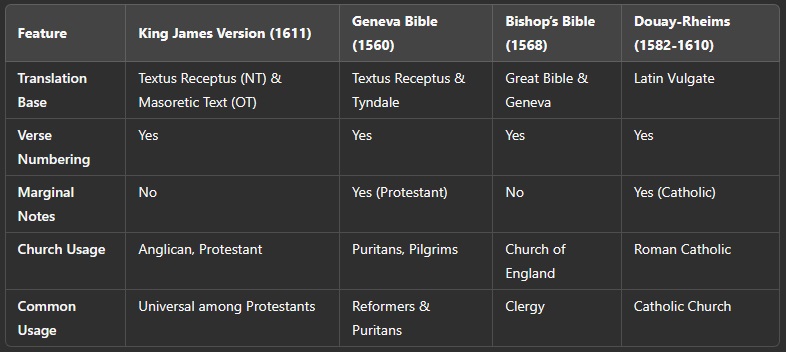
Unlike the Geneva Bible, which contained extensive commentary, the KJV focused only on translation, ensuring it was free of political and doctrinal bias.
Doctrinal Integrity & Translation Accuracy
Faithfulness to the Original Text
The KJV translators worked diligently to ensure that their work was as close as possible to the original Hebrew and Greek manuscripts. Unlike later translations influenced by the Westcott & Hort Critical Text, the KJV preserved the traditional text used by Christians for centuries.
Theological Emphasis
Christ’s Divinity: Strongly affirmed (e.g., 1 Timothy 3:16).
Blood Atonement: Emphasized in verses like Colossians 1:14.
The Trinity: Supported by verses like 1 John 5:7.
Satan’s Identity: Maintains “Lucifer” in Isaiah 14:12, unlike modern versions.
By preserving key doctrinal passages, the KJV ensures that essential Christian beliefs remain intact, unlike many modern translations that omit or alter critical verses.
Persecution & Controversy
Why Was the KJV Created?
To replace the Bishop’s Bible (1568), which was considered poorly translated.
To end the dominance of the Geneva Bible, which contained anti-monarchical notes.
To unify English-speaking Christians under one authoritative translation.
Opposition to the KJV
Puritans rejected it at first because it lacked marginal commentary.
Catholics opposed it since it was based on the Textus Receptus rather than the Latin Vulgate.
Modern scholars attack it today, claiming newer versions are more “accurate” (despite using corrupted manuscripts like Vaticanus and Sinaiticus).
Though initially met with skepticism, the KJV became the gold standard of English Bible translations.
Notable Features & Innovations
1. Linguistic Excellence
The KJV is known for its majestic, poetic style, which has deeply influenced English literature and public worship.
2. Standardized English Bible
Unlike earlier translations, which had inconsistent spellings and grammar, the KJV set a standard that shaped the English language.
3. No Doctrinal Commentary
Unlike the Geneva Bible, the KJV does not contain theological interpretations, allowing Scripture to speak for itself.
Key Textual Differences
Examples of Verses Affected
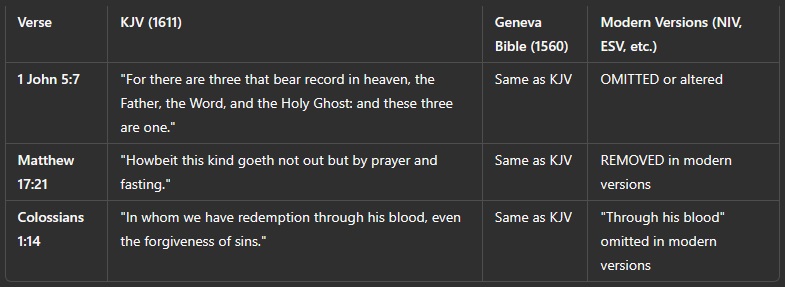
The KJV preserves key doctrines that modern translations have removed or altered, ensuring doctrinal consistency with the early church.
Legacy & Modern Usage
Why the KJV Still Matters
It remains the most widely read and printed Bible in history.
It has shaped Christian theology and Western culture for over 400 years.
It is based on the preserved, traditional manuscripts rather than the corrupted Critical Text used in modern translations.
Modern Reprints & Accessibility
The 1611 edition is available for historical study.
The 1769 Cambridge Edition (with spelling updates) is the most commonly used version today.
Remains the primary Bible for many Protestant denominations.
Conclusion: The Gold Standard of English Bibles
The King James Version (1611) is the most enduring, doctrinally pure, and widely read English Bible translation. Unlike modern versions, which rely on corrupt manuscripts, the KJV remains faithful to the preserved Word of God.
📖 Next, we will analyze the rise of modern translations and their deviations from the traditional text.
✅ The King James Version (1769) – A Refinement of the 1611 Edition
The King James Version (1769) is the standardized edition of the original 1611 King James Bible. It was revised by Benjamin Blayney at Oxford University to correct typographical inconsistencies, modernize spelling, and refine punctuation. This version is the most widely used KJV edition today, as the 1611 original contained archaic English spellings that made reading difficult for later generations.
📜 Key Historical Facts:
A revision of the 1611 KJV, not a new translation.
Modernized spellings (e.g., sonne → son, shee → she).
Standardized punctuation and italics for better readability.
Removed some printing errors from the original.
Became the most widely accepted edition of the KJV.
Comparison: 1611 KJV vs. 1769 KJV

Doctrinal Integrity & Preservation
The 1769 revision did not alter the text’s meaning but refined it for clarity and consistency. It remained faithful to the Textus Receptus and the Masoretic Text, ensuring that core doctrines, including:
The deity of Christ (John 1:1).
The atoning blood of Jesus (Colossians 1:14).
The Trinity (1 John 5:7).
The unchanging nature of God’s Word (Psalm 12:6-7).
Notable Features of the 1769 KJV
1. Standardized English Spelling
“Iesus” (1611) → “Jesus” (1769)
“sinne” (1611) → “sin” (1769)
2. Italicization for Added Words
Words added for grammatical clarity (but not found in the Greek/Hebrew) were italicized. This was a transparency feature to help readers distinguish translation additions.
3. Margin Consistency
Cross-references and notes were made clearer and more uniform.
Legacy & Modern Usage
The 1769 KJV remains the standard edition of the King James Bible used today. It is:
The most printed book in history.
The foundation for many doctrinal teachings.
Used by millions of believers worldwide.
While some later revisions (such as the NKJV) attempted to modernize the KJV, many Christians continue to view the 1769 KJV as the preserved Word of God in English, standing against modern critical text-based translations.
Conclusion: The Most Enduring Bible Translation
The King James Version (1769) refined the 1611 KJV, ensuring textual clarity, standardization, and typographical corrections. It remains the most widely used and trusted Bible version among believers today.
📖 Next, we will analyze the English Revised Version (1885) and its impact on modern translations.
The Corruption of the Critical Text – Distorting God’s Word
⚖️ What Is the Critical Text?
The Critical Text is the modern Greek New Testament text used as the basis for nearly all modern Bible translations, including the NIV, ESV, CSB, NASB, and RSV. It deviates significantly from the Textus Receptus, the manuscript tradition that preserved God’s Word for centuries and was used in the King James Bible (KJV).
The Critical Text primarily comes from the Nestle-Aland Greek New Testament and the Westcott & Hort text (1881), which were based on a small number of corrupt Alexandrian manuscripts—particularly Codex Vaticanus and Codex Sinaiticus. These texts differ in thousands of places from the traditional Majority Text that had been used by Christians for over 1,500 years.
How the Critical Text Distorts God’s Word
The Critical Text has led to the systematic removal and alteration of key biblical doctrines, including those related to Christ’s divinity, the Trinity, salvation, and spiritual warfare.
Key Changes Introduced by the Critical Text
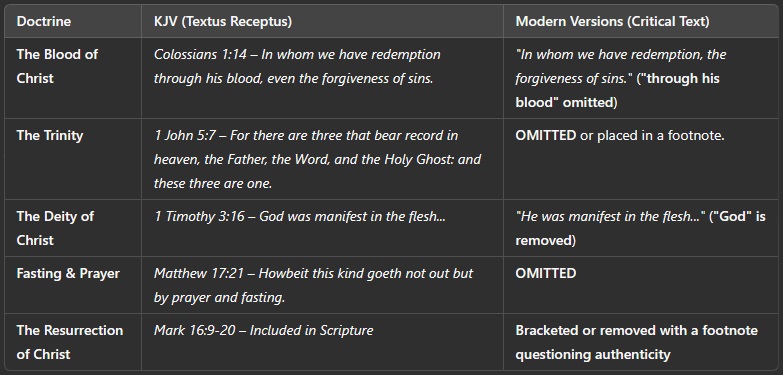
These changes strip away essential Christian doctrines, weakening the Bible’s authority and causing confusion among believers.
The Origins of the Critical Text – Westcott & Hort’s Deception
The Critical Text movement began in 1881 with Brooke Foss Westcott and Fenton John Anthony Hort, two Anglican scholars who openly rejected the traditional Textus Receptus in favor of the Alexandrian manuscripts (Vaticanus & Sinaiticus).
What Did Westcott & Hort Believe?
They denied the infallibility of Scripture, considering the Bible to be just another ancient text.
They leaned toward Roman Catholic theology, favoring Vaticanus, a manuscript housed in the Vatican.
They embraced evolution and rejected a literal interpretation of Genesis.
They altered the Greek New Testament in over 5,000 places, many of which removed references to Christ’s deity and essential Christian doctrines.
Westcott & Hort’s Greek New Testament became the foundation for the Nestle-Aland text, which is used in nearly every modern Bible today.
Why the Critical Text Must Be Rejected
1. It Is Based on Corrupt Manuscripts
The Critical Text is based on a handful of Alexandrian manuscripts, which were:
Rarely used by the early church.
Disagreed with each other in thousands of places.
Omitted large portions of Scripture, including entire verses.
2. It Removes or Weakens Key Doctrines
By following the Critical Text, modern translations erase references to the blood of Christ, the Trinity, fasting, and even elements of Christ’s resurrection.
3. It Opens the Door to Further Corruption
Since the Critical Text is revised regularly, newer editions introduce more changes, more omissions, and more distortions, leading to further doctrinal decay.
Conclusion: The Critical Text Is the Foundation of Modern Bible Corruption
The Critical Text is a tool of deception, subtly altering God’s Word while claiming to be more “accurate.” Every major modern Bible translation—NIV, ESV, CSB, NASB, RSV—is built on this corrupted foundation. By rejecting the Textus Receptus and the KJV, these translations lead believers further from the truth and closer to confusion.
🔥 The solution? Stand on the preserved Word of God in the KJV, which is rooted in the faithful Textus Receptus and the Majority Text.
The English Revised Version (1885) – The First Major Corruption of Scripture
The English Revised Version (1885) (ERV) marked the first major departure from the preserved text of the King James Bible (KJV). It was created under the pretense of updating archaic language, but in reality, it introduced a new textual foundation based on the corrupt Alexandrian manuscripts, drastically altering key doctrinal verses.
📜 Key Historical Facts:
Commissioned in 1870 by the Church of England, but heavily influenced by Westcott & Hort.
Published in 1885, breaking from the Textus Receptus and embracing the Alexandrian text-type (Vaticanus & Sinaiticus).
Omitted, altered, or questioned over 200 verses, undermining foundational doctrines.
Laid the groundwork for further corrupt translations, leading to the modern critical text movement.
This was the first English translation to systematically remove verses, weaken Christ’s deity, and introduce confusion in key theological passages.
Doctrinal Corruption & Theological Shifts
1. A Direct Attack on Christ’s Deity & The Blood of Atonement
The ERV systematically removed or altered verses that affirm:
The divinity of Christ
The blood atonement
The authority of God’s Word
Salvation by faith
Key Omissions & Doctrinal Changes
The removal of 1 John 5:7 attacks the doctrine of the Trinity, while removing Colossians 1:14 (“through his blood”) undermines the doctrine of salvation.
Westcott & Hort’s Role in the Corruption
The ERV’s greatest error was its dependence on Westcott & Hort’s Greek New Testament, a man-made text built on the Vaticanus & Sinaiticus manuscripts, which differ from the Received Text in over 5,000 places.
Who Were Westcott & Hort?
They rejected the Textus Receptus, calling it corrupt, despite it being used for over 1,500 years.
Both men held unorthodox theological views, doubting biblical miracles and the atonement.
Their influence led to the mass removal of entire verses, making the ERV the first English Bible to follow a corrupt manuscript tradition.
This laid the foundation for modern Bible corruption, as later translations continued to build on their work.
Legacy of the ERV: The Beginning of the Modern Apostasy
Why the ERV Must Be Rejected
It was the first step in replacing the KJV with corrupt translations.
It weakened critical doctrines, setting the stage for even worse changes in the RSV, NIV, and ESV.
It led to mass confusion, with footnotes questioning the authenticity of entire sections of Scripture.
It influenced every modern Bible based on the Critical Text, ensuring that each new version would drift further from God’s Word.
Current Availability & Lasting Impact
Though largely obsolete today, the ERV’s legacy lives on in modern corrupt translations. Many of its changes were later adopted by the RSV, NIV, ESV, and other Bibles, which continue to remove key doctrines and dilute the truth of Scripture.
Conclusion: The English Revised Version Was the First Major Attack on God’s Word
The English Revised Version (1885) introduced large-scale corruption into English Bible translations. By abandoning the Textus Receptus, it opened the floodgates for future removals, alterations, and theological weakening that have progressively led believers away from the pure Word of God.
📖 Next, we will analyze the American Standard Version (1901) and how it continued the decline.
The American Standard Version (1901) – A Further Step Away from the Truth
The American Standard Version (ASV) of 1901 was a continuation of the corruption that began with the English Revised Version (1885). It was promoted as an improvement to the ERV, yet it continued the same departure from the Textus Receptus, further weakening critical doctrines and embracing the Critical Text tradition.
📜 Key Historical Facts:
Created as the American counterpart to the English Revised Version (1885).
Published in 1901 with the same Westcott & Hort-influenced Critical Text.
Introduced Jehovah as a replacement for “LORD” in the Old Testament, leading to doctrinal confusion.
Continued the omission of key verses found in the KJV but removed in the ERV.
Served as the basis for even further corrupt versions, including the Revised Standard Version (1952) and New American Standard Bible (1971).
While it claimed to be a more accurate English translation, in reality, the ASV carried forward the doctrinal errors of the ERV, ensuring the continued erosion of biblical truth.
Doctrinal Corruption & Theological Shifts
The ASV continued the attack on foundational Christian doctrines by perpetuating verse omissions and textual alterations from the ERV.
Key Omissions & Doctrinal Changes
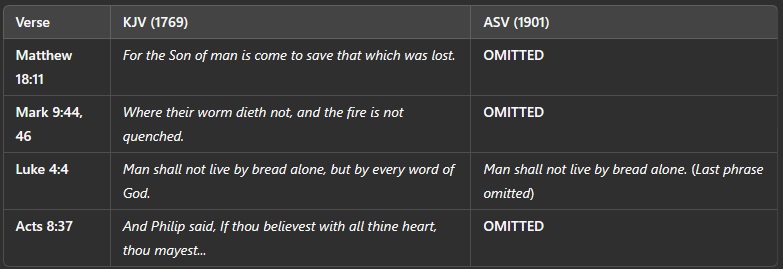
These removals weakened key doctrines related to salvation, eternal punishment, and the power of God’s Word, continuing the trend of Scripture dilution that began with the ERV.
The Influence of the Westcott & Hort Greek Text
The ASV cemented Westcott & Hort’s corrupt manuscript theories, further embedding the use of the Alexandrian text-type (Vaticanus & Sinaiticus) instead of the Textus Receptus, which had preserved the Word of God for centuries.
How Did the ASV Continue the Corruption?
Adopted more of the Critical Text changes, leading to further doctrinal confusion.
Replaced “LORD” with “Jehovah” in the Old Testament, a move later exploited by cults like the Jehovah’s Witnesses.
Set the stage for more liberal translations, including the RSV (1952), NASB (1971), and ESV (2001).
This further diminished confidence in God’s preserved Word and pushed the church deeper into textual confusion.
Legacy of the ASV: Weakening the Foundation for Future Translations
Why the ASV Must Be Rejected
Furthered the corrupt textual changes introduced by the ERV.
Weakened key verses concerning salvation, fasting, and Christ’s mission.
Introduced the Jehovah confusion, setting the stage for doctrinal misuse by false religions.
Paved the way for even worse translations, leading to the modern Critical Text-based Bibles.
Current Availability & Lasting Impact
Though largely obsolete today, the ASV’s changes were absorbed into later translations, ensuring that each new Bible version would drift further from God’s Word.
Conclusion: The ASV Helped Cement the Modern Corruption of Scripture
The American Standard Version (1901) continued the compromise of biblical truth, embedding Westcott & Hort’s Critical Text into mainstream Bible translation efforts. It paved the way for future revisions that would remove even more of God’s Word, preparing the stage for the Revised Standard Version (1952) and beyond.
📖 Next, we will analyze the Revised Standard Version (1952) and its deeper compromises.
The Revised Standard Version (1952) – A Deeper Compromise of Biblical Truth
The Revised Standard Version (RSV) of 1952 was a direct descendant of the American Standard Version (1901) and marked another dangerous step away from the preserved Word of God. It continued the use of Critical Text manuscripts, making even more significant doctrinal alterations, particularly in prophetic and Christological passages.
📜 Key Historical Facts:
Commissioned by the International Council of Religious Education (ICRE).
Published in 1952 as a revision of the ASV (1901).
Further embraced the Westcott & Hort Critical Text, ignoring the Textus Receptus.
First Bible to be influenced by the Dead Sea Scrolls, despite their questionable origins.
Openly rejected traditional Christian doctrines, especially prophecies concerning Christ.
The RSV’s compromises with liberal theology and weakened doctrine led to outrage from conservative believers, many of whom recognized it as a blatant attempt to dilute God’s Word.
Doctrinal Corruption & Theological Shifts
The RSV went even further than the ASV in undermining key doctrinal passages. It contained dangerous changes that weakened biblical prophecy, the divinity of Christ, and the authority of Scripture.
Key Omissions & Doctrinal Changes
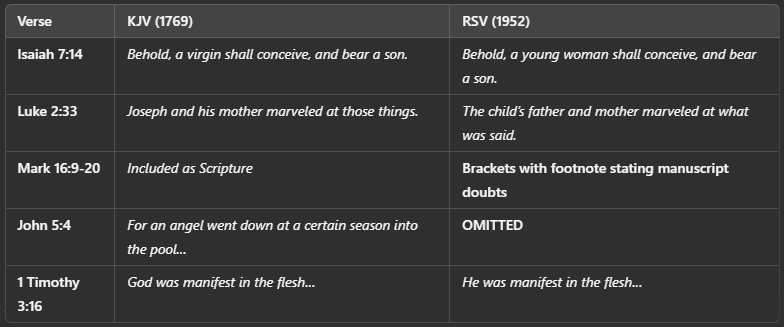
1. The “Virgin” vs. “Young Woman” Controversy (Isaiah 7:14)
The RSV deliberately weakened the prophecy of Christ’s virgin birth, replacing “virgin” with “young woman,” directly attacking Matthew 1:23, which confirms Christ’s birth as a divine miracle.
2. Removal of “God” in 1 Timothy 3:16
The RSV replaced “God was manifest in the flesh” with “He was manifest in the flesh”, eliminating a crucial statement of Christ’s divinity.
3. Questioning of Mark 16:9-20
By placing Mark 16:9-20 in brackets with a footnote casting doubt on its authenticity, the RSV undermined the resurrection account, creating unnecessary confusion.
These changes systematically eroded confidence in God’s Word and weakened core doctrines, paving the way for more liberal theology.
A Bible Aligned with Liberal Theology
The RSV was not just a revision—it was a theological attack on biblical authority. Many of its translators were influenced by modernist theology, which denied miracles, questioned prophecy, and sought to redefine Christ’s identity.
Why the RSV Was Dangerous
Weakened Christ’s divinity – By altering passages concerning His virgin birth and manifestation in the flesh.
Undermined prophecy – Isaiah 7:14 was altered to disconnect it from Christ’s fulfillment.
Followed the Critical Text – Ignored the Textus Receptus, following corrupt Alexandrian manuscripts.
Created doubt in Scripture – Introduced footnotes questioning passages long accepted by Christians.
The RSV’s liberal approach made it the preferred translation for denominations that sought to compromise biblical truth.
Legacy of the RSV: Opening the Floodgates for Further Corruption
Why the RSV Must Be Rejected
It continued the modernist agenda of stripping key doctrines from the Bible.
It became a stepping stone to the even more corrupt New Revised Standard Version (NRSV) (1989).
It attacked the deity of Christ, removing or weakening verses confirming His divine nature.
It allowed liberal theologians to dictate translation choices, rather than preserving God’s Word.
Current Availability & Lasting Impact
The RSV eventually lost favor among conservative Christians, but its legacy of textual corruption lived on in the NRSV, ESV, and modern translations that continued to drift further from the preserved text.
Conclusion: The RSV Was a Tool of Doctrinal Compromise
The Revised Standard Version (1952) played a major role in weakening biblical authority, opening the door for more liberal, watered-down translations. Its changes to Christological and prophetic passages reveal a deliberate attempt to alter God’s Word, setting the stage for even greater distortions in modern translations.
📖 Next, we will analyze the New American Standard Bible (NASB) (1971, 1995, 2020) and how it continued the erosion of truth.
The New American Standard Bible (NASB) – 1971, 1995, 2020
The New American Standard Bible (NASB) was introduced in 1971 as an attempt to create a more accurate English translation while maintaining modern readability. However, while marketed as a “literal” translation, the NASB continued the dangerous reliance on the Critical Text, following in the footsteps of the Revised Standard Version (RSV) and further eroding confidence in the preserved Word of God.
📜 Key Historical Facts:
The NASB (1971) was developed by the Lockman Foundation, heavily influenced by the ASV (1901) and Critical Text manuscripts.
The NASB (1995) updated the text for readability but continued its omissions and textual alterations.
The NASB (2020) modernized gender language and further adjusted phrases, introducing even more liberalized changes.
Despite being advertised as “the most literal English Bible,” the NASB follows the Westcott & Hort tradition, making it another step away from the Textus Receptus.
While the NASB is less theologically liberal than the RSV, it still removes key verses and subtly undermines the doctrinal integrity found in the KJV.
Doctrinal Corruption & Theological Shifts
While often praised for being word-for-word accurate, the NASB follows the same Critical Text methodology that leads to omissions, weakened Christological references, and textual doubts.
Key Omissions & Doctrinal Changes
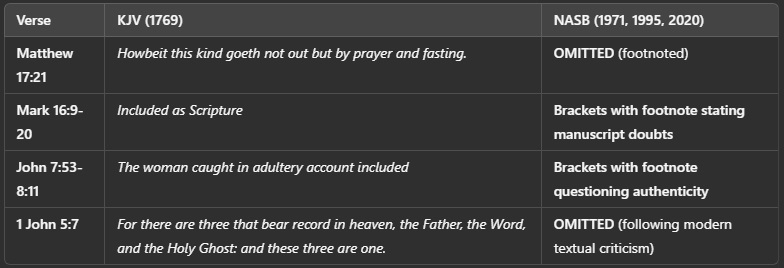
While the NASB keeps a word-for-word structure, it removes or brackets entire passages, introducing doubt about Scripture’s authenticity and diminishing confidence in the Word of God.
Compromising for Readability & Modern Trends
The 2020 update of the NASB moved even further from biblical accuracy, introducing:
Gender-neutral language, altering the meaning of certain passages.
More phrase adjustments, further softening the impact of God’s Word.
Increased alignment with liberal translations, making it less distinct from the NIV and ESV.
This pattern follows the dangerous trend of softening biblical language, making Scripture more palatable for modern readers while compromising doctrinal purity.
Legacy of the NASB: A Step Toward Further Corruption
Why the NASB Must Be Rejected
It follows the Westcott & Hort Critical Text, deviating from the preserved Word of God.
It removes or questions key verses, including those concerning fasting, Christ’s deity, and the Trinity.
The 2020 edition introduces modernist compromises, making it less reliable than ever.
It serves as a stepping stone to even worse translations, including the NIV and ESV, which continue the dilution of Scripture.
Current Availability & Lasting Impact
The NASB is still widely used today, particularly in seminaries and academic circles, but it has never reached the widespread acceptance of the KJV, as many believers recognize its compromises and omissions.
Conclusion: The NASB Is Not the Preserved Word of God
The New American Standard Bible (1971, 1995, 2020) was promoted as an accurate and scholarly translation, yet its foundation in the Critical Text tradition ensures that it continues the trend of Scripture dilution. With each revision, the NASB drifts further from the preserved truth of the KJV, making it a dangerous choice for those who seek the true Word of God.
📖 Next, we will analyze the New International Version (NIV) (1978, 1984, 2011) and its widespread influence on modern Christianity.
The New International Version (NIV) – 1978, 1984, 2011
The New International Version (NIV), first published in 1978, was marketed as a dynamic equivalent translation, meaning it prioritized “thought-for-thought” rendering over “word-for-word” accuracy. While claiming to be an accessible and modern translation, the NIV follows the Critical Text tradition and represents one of the most extensive departures from the Textus Receptus, leading to severe doctrinal dilution and omissions.
📜 Key Historical Facts:
The NIV (1978) was developed by a multi-denominational committee, relying on Critical Text manuscripts (Nestle-Aland/Westcott & Hort).
The NIV (1984) made minor refinements but retained the same underlying philosophy.
The NIV (2011) introduced gender-neutral language and further departures from literal translation.
Over 64,000 words were removed from the KJV, altering the meaning of hundreds of verses.
While the NIV is the most widely sold modern translation, it is also one of the most doctrinally compromised, following a progressive pattern of omissions and alterations.
Doctrinal Corruption & Theological Shifts
The NIV aggressively removes, weakens, or distorts Scripture, affecting crucial doctrines related to Christ’s divinity, salvation, and spiritual warfare.
Key Omissions & Doctrinal Changes
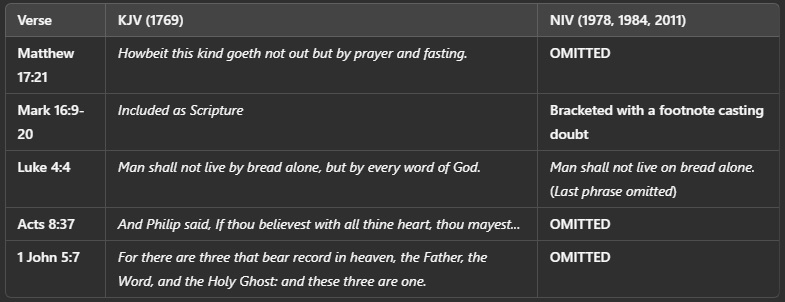
The removal of these verses directly attacks key doctrines such as:
The necessity of prayer and fasting (Matthew 17:21).
The resurrection account in Mark 16.
The doctrine of the Trinity (1 John 5:7).
By removing words and entire verses, the NIV systematically weakens the Bible, aligning with modernist theology rather than the preserved Word of God.
Compromising for Modern Culture
The NIV (2011) introduced gender-neutral language, changing key words that affect biblical doctrine:
“He” → “They”
“Brothers” → “Brothers and sisters”
“Son of Man” (a title of Christ) altered to a less distinct form in certain passages.
These changes soften the clarity of Scripture, making the NIV conform to cultural trends rather than biblical truth.
Legacy of the NIV: The Most Widespread Corruption of Scripture
Why the NIV Must Be Rejected
It removes entire verses, including those supporting fasting, the Trinity, and Christ’s mission.
It changes doctrine by altering key words, diminishing the strength of biblical truth.
The 2011 edition introduces modernist compromises, making it more aligned with political correctness than sound doctrine.
It has influenced many other corrupt translations, including the ESV, NLT, and other modern versions.
Current Availability & Lasting Impact
The NIV remains the best-selling modern Bible, despite its severe doctrinal compromises. Its influence has led to a general acceptance of watered-down translations, making it one of the most dangerous modern Bibles in circulation.
Conclusion: The NIV Represents the Height of Modern Bible Corruption
The New International Version (1978, 1984, 2011) is one of the most compromised Bible translations in history. By prioritizing readability over doctrinal accuracy, it has become a gateway to further scriptural distortion, paving the way for even greater compromises in modern Bible versions.
📖 Next, we will analyze the English Standard Version (ESV) (2001) and its impact on biblical interpretation.
The New King James Version (NKJV) – 1982
The New King James Version (NKJV) was published in 1982 as an attempt to “update” the King James Bible (KJV) while maintaining its traditional manuscript base. However, while the NKJV claims to follow the Textus Receptus, its underlying influences from modern textual criticism raise concerns about its faithfulness to the original KJV.
📜 Key Historical Facts:
Commissioned by Thomas Nelson Publishers, promoted as a “modern KJV.”
Sought to replace archaic words while retaining KJV structure.
Claimed to follow the Textus Receptus, but incorporated footnotes from the Critical Text (Nestle-Aland manuscripts).
Introduced subtle textual shifts that align with modern translations.
Though it appears to preserve the foundation of the KJV, the NKJV contains textual compromises that open the door for modernist interpretations.
Doctrinal Integrity & Theological Shifts
While the NKJV retains many traditional verses, it introduces subtle changes that weaken biblical clarity and confuse manuscript authority.
Key Differences & Theological Concerns

These subtle word changes may appear minor, but they shift meaning, leading to different interpretations over time. The NKJV’s use of Critical Text footnotes also raises doubt about the authenticity of key KJV readings, even though they are included in the main text.
The Hidden Danger: Opening the Door to the Critical Text
While the NKJV claims to follow the Textus Receptus, it frequently references Critical Text variants in footnotes, such as:
“NU-text omits this verse…”
“Majority Text reads differently…”
This subtle compromise plants doubt about the authority of the Textus Receptus, making it easier for readers to eventually accept modern Critical Text-based Bibles like the NIV, ESV, and NASB.
How the NKJV Paved the Way for Further Corruption
Introduced modernized wording that aligns with later versions.
Included manuscript footnotes that cast doubt on traditional readings.
Served as a stepping stone toward accepting full Critical Text-based translations.
While not as corrupt as the NIV, the NKJV still subtly erodes confidence in the preserved Word of God.
Legacy of the NKJV: A Trojan Horse Translation?
Why the NKJV Must Be Examined Carefully
Claims to be based on the Textus Receptus, yet introduces Critical Text influence.
Rewords key passages, altering doctrinal clarity.
Includes footnotes that weaken confidence in the traditional text.
Was promoted as a “safe alternative” to the KJV, but serves as a bridge to more corrupt translations.
Current Availability & Lasting Impact
The NKJV remains widely used, especially by those who find the KJV’s language difficult, but it fails to fully preserve the authority of the traditional text. Many who begin with the NKJV eventually transition to more liberal translations due to its acceptance of modern textual criticism.
Conclusion: The NKJV Opens the Door to Further Compromise
The New King James Version (1982) presents itself as a faithful update to the KJV, but its subtle changes, Critical Text footnotes, and modernized wording make it a bridge toward doctrinal erosion. While it may appear close to the KJV, its compromises reveal a dangerous shift in manuscript trust.
📖 Next, we will analyze the English Standard Version (ESV) (2001) and its impact on biblical interpretation.
The English Standard Version (ESV) – 2001
The English Standard Version (ESV), first published in 2001, was promoted as a “conservative” alternative to modern translations while maintaining the accuracy of the original manuscripts. However, beneath the surface, the ESV is another Critical Text-based translation that follows the same corrupt manuscript tradition as the NIV, RSV, and NASB.
📜 Key Historical Facts:
Developed by Crossway, based on the Revised Standard Version (RSV) (1971), which was already heavily influenced by modern textual criticism.
Uses the Nestle-Aland / Critical Text manuscripts, deviating from the Textus Receptus.
Marketed as a “literal” translation, yet follows the same omission patterns as other modern Bibles.
Continues the pattern of doctrinal weakening and textual corruption.
Though popular among reformed and evangelical circles, the ESV ultimately reinforces the same manuscript errors that led to the widespread dilution of God’s Word in modern translations.
Doctrinal Corruption & Theological Shifts
While praised for its word-for-word approach, the ESV follows the same Critical Text philosophy that leads to the removal or alteration of key doctrinal verses.
Key Omissions & Doctrinal Changes
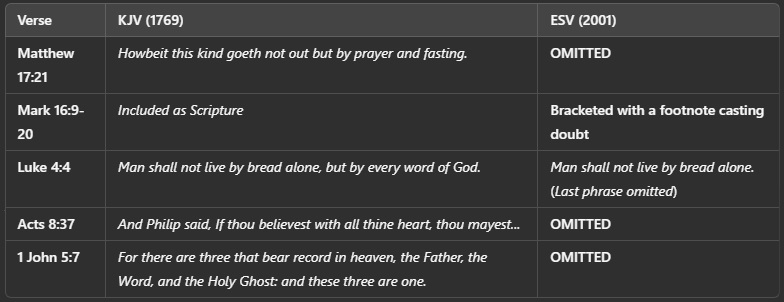
The ESV’s omissions and alterations directly weaken fasting and prayer (Matthew 17:21), the doctrine of the Trinity (1 John 5:7), and the authenticity of the resurrection account (Mark 16:9-20).
The Hidden Danger: Disguised as a Conservative Bible
The ESV is often marketed as a more “conservative” version of the Bible, appealing to those who reject the NIV’s liberal influence. However, it is built on the same corrupt foundation, making it another Trojan Horse translation.
How the ESV Paved the Way for Further Corruption
Maintains the same omissions as the NIV & RSV, continuing the dilution of Scripture.
Lowers resistance to modern textual criticism, subtly eroding trust in the KJV.
Aligns with liberal academic influences, despite being marketed as “conservative.”
While less aggressively modernized than the NIV, the ESV still carries the DNA of textual corruption, leading to subtle doctrinal erosion over time.
Legacy of the ESV: A Cleverly Packaged Compromise
Why the ESV Must Be Rejected
It follows the Nestle-Aland / Critical Text, rejecting the preserved Word of God.
It removes key verses, just like the NIV and RSV.
It subtly shifts doctrinal emphasis, weakening confidence in the complete Word of God.
It is disguised as a “conservative” Bible, but ultimately follows the same corrupt textual tradition.
Current Availability & Lasting Impact
The ESV has gained popularity among evangelicals and reformed theologians, but its underlying textual corruption makes it a dangerous alternative to the true, preserved Word of God in the KJV.
Conclusion: The ESV Is a Rebranded RSV with the Same Corrupt Roots
The English Standard Version (2001) is often presented as a trustworthy alternative to modernized translations, but it is nothing more than a repackaged version of the RSV, which was already compromised. By removing verses, altering doctrinal passages, and following the Critical Text, the ESV serves as another step away from the preserved Word of God.
📖 Next, we will analyze the Christian Standard Bible (CSB) (2017) and its impact on modern Bible translation.
The Christian Standard Bible (CSB) – 2017
The Christian Standard Bible (CSB), published in 2017 by Holman Bible Publishers, was developed as an update to the Holman Christian Standard Bible (HCSB) (2004). Marketed as a balanced translation between readability and accuracy, the CSB follows the same Critical Text-based translation philosophy as the NIV, ESV, and NASB, continuing the trend of textual corruption and doctrinal dilution.
📜 Key Historical Facts:
Released in 2017 as a revision of the HCSB (2004).
Uses the Nestle-Aland / Critical Text manuscripts, rejecting the Textus Receptus.
Adopts a “dynamic equivalence” approach, prioritizing “thought-for-thought” over “word-for-word” translation.
Further incorporates gender-neutral language, aligning with modern cultural shifts.
Designed for Southern Baptist and evangelical churches, but ultimately follows the same pattern of compromise as other modern versions.
Though widely accepted by mainstream evangelicals, the CSB is yet another step away from the preserved Word of God, blending modern linguistic trends with Critical Text omissions.
Doctrinal Corruption & Theological Shifts
Like the NIV and ESV, the CSB removes or weakens key biblical passages, especially those related to Christ’s divinity, fasting, and spiritual warfare.
Key Omissions & Doctrinal Changes
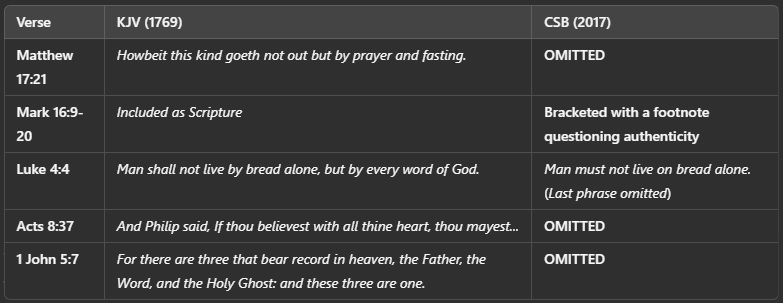
These alterations mirror the corruptions in the NIV and ESV, systematically removing references to fasting, the Trinity, and key doctrines related to Christ’s authority.
A Bible Designed for Cultural Acceptance
The CSB is one of the most culturally adapted modern Bibles, making significant concessions to progressive ideology:
Gender-neutral terms are frequently used in place of masculine pronouns.
Doctrinal clarity is sacrificed in favor of “modern readability.”
Aligns with liberal textual criticism, following the same manuscript corruptions as the NIV and ESV.
Though it claims to be faithful to the original manuscripts, the CSB ultimately prioritizes cultural trends over biblical accuracy, making it a dangerous translation for serious believers.
Legacy of the CSB: The Final Step in Doctrinal Dilution
Why the CSB Must Be Rejected
It follows the Nestle-Aland / Critical Text, rejecting the preserved Word of God.
It removes and alters key verses, continuing the pattern of modern textual corruption.
It conforms to cultural trends, softening biblical doctrine for mass appeal.
It is designed for readability at the cost of doctrinal accuracy, making it a dangerous tool for deception.
Current Availability & Lasting Impact
The CSB has quickly gained popularity among evangelicals, but its progressive textual approach makes it one of the most compromised translations to date. It is a continuation of the modern trend toward Scripture dilution, leading believers further away from the true, preserved Word of God.
Conclusion: The CSB is a Modernized Bible for a Compromised Church
The Christian Standard Bible (2017) is one of the most culturally adapted and doctrinally weakened translations in history. By removing verses, altering doctrinal passages, and following the Critical Text, the CSB continues the long trend of modern Bible corruption. It represents the final step in making the Bible palatable to a world that no longer desires the truth.
Understanding the Geneva Bible vs. King James Version
The claim that the King James Version (KJV) changed important texts from the Geneva Bible (1560) is a topic of much debate among scholars and believers. Some argue that the KJV made alterations that softened certain politically charged phrases, while others argue that it refined and improved the translation based on superior manuscript evidence.
The Geneva Bible (1560) was the leading English translation before the KJV. It was the first English Bible with numbered verses, and it was popular among the Puritans and early American settlers. The King James Version (1611) was commissioned by King James I of England and aimed to unify English-speaking Christians under one Bible.
Both translations were based on the Textus Receptus (TR) for the New Testament and the Masoretic Text for the Old Testament. However, the Geneva Bible often included strongly Calvinist footnotes that criticized monarchy and papal authority—something King James explicitly disliked.
2. Key Differences Between the Geneva Bible and KJV
Here are some notable differences and controversial changes:
A. Romans 4:6 – Justification by Faith
- Geneva Bible (1560):
“Even as David describeth the blessedness of the man, unto whom God imputeth righteousness without works.” - King James Version (1611):
“Even as David also describeth the blessedness of the man, unto whom God imputeth righteousness without works.”
🔎 Difference:
The Geneva Bible uses “Even as David describeth,” while the KJV adds “also” before “describeth.” The addition of “also” does not change doctrine but clarifies the connection between David’s statement and Paul’s argument.
B. Acts 12:4 – Easter vs. Passover
- Geneva Bible (1560):
“And when he had caught him, he put him in prison, and delivered him to four quaternions of soldiers to be kept, intending after the Passover to bring him forth to the people.” - King James Version (1611):
“And when he had apprehended him, he put him in prison, and delivered him to four quaternions of soldiers to keep him; intending after Easter to bring him forth to the people.”
🔎 Difference:
The Geneva Bible correctly translates πασχα (Pascha) as Passover, while the KJV translates it as Easter.
Critics argue that “Easter” is an anachronism, since the pagan festival of Ishtar (Eostre) had no connection to the biblical Passover. However, KJV defenders argue that “Easter” was used in reference to Herod’s pagan festival rather than the Jewish feast.
C. Hebrews 10:14 – Salvation and Sanctification
- Geneva Bible (1560):
“For with one offering hath he consecrated forever them that are sanctified.” - King James Version (1611):
“For by one offering he hath perfected forever them that are sanctified.”
🔎 Difference:
The Geneva Bible uses “consecrated” while the KJV uses “perfected.”
KJV advocates argue that “perfected” more accurately reflects the Greek word τετελείωκεν (teteleióken), meaning “to make complete.” Critics claim that the KJV’s word choice changes the theological emphasis, though both convey the sufficiency of Christ’s sacrifice.
D. 1 John 5:7 – The Johannine Comma
- Geneva Bible (1560):
“For there are three which bear record in heaven, the Father, the Word, and the holy Ghost: and these three are one.” - King James Version (1611):
“For there are three that bear record in heaven, the Father, the Word, and the Holy Ghost: and these three are one.”
🔎 Difference:
The Geneva Bible already contained the Johannine Comma, which is often debated as a later addition to Greek manuscripts. The KJV retained it, following the Textus Receptus, while most modern versions omit it due to lack of support in early Greek manuscripts.
3. Political and Doctrinal Reasons for Differences
Many believe the biggest differences between the Geneva Bible and KJV were not in translation accuracy but in political and doctrinal emphasis.
King James disliked the Geneva Bible’s anti-monarchy footnotes.
- Example: The Geneva Bible criticized kings and popes, aligning with Puritan ideals.
- The KJV was meant to be a “neutral” translation without anti-authoritarian footnotes.
The Geneva Bible was widely used by the Puritans, whom King James opposed.
- The Puritans were strong advocates of biblical authority over human rulers.
- The KJV was meant to unify the Church of England and eliminate “seditious” interpretations.
Translation Choices in the KJV Often Reflect a More Monarchical Tone.
- Example: The Geneva Bible translates “tyrant” in places where the KJV translates it as “king.”
- The KJV softens some phrases that could be seen as rebellious.
4. Was the KJV a Corruption of the Geneva Bible?
🔹 NO, but it was influenced by political and ecclesiastical motivations.
🔹 YES, in the sense that some word choices removed strong anti-monarchist language.
🔹 NO, in that the KJV was a scholarly work based on original-language texts, not just a revision of the Geneva Bible.
🔎 Conclusion:
The Geneva Bible and KJV are both based on the Textus Receptus, but the KJV aimed to replace the Geneva Bible for political and ecclesiastical reasons. It was not a corruption but a refinement—although some word choices reflect King James’ desire to remove anti-royal sentiment.
The doctrinal integrity of the KJV remains intact, and its legacy as a faithful English translation is strong—but understanding its political background helps clarify why some changes were made.
5. Should Christians Use the Geneva Bible Instead of the KJV?
Both the Geneva Bible and KJV hold significant historical importance, but:
✅ If you want a Bible with early Protestant perspectives and Puritan notes, the Geneva Bible is valuable.
✅ If you want a Bible free of political footnotes but with refined textual accuracy, the KJV is superior.
✅ If you believe in the providential preservation of the Bible, the KJV (1769 edition) is the standard.
Final Thought: The KJV did not corrupt the Geneva Bible, but it did shape English Christianity in a different direction. Understanding these differences deepens appreciation for textual history and the battle for the true Word of God.

